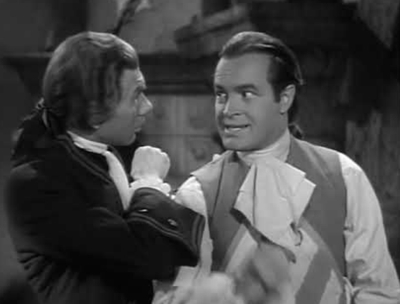
Grade: B+
Comedy
Not rated (would be PG)
What do Rudolph Valentino and Bob Hope have in common?
They both played the title character in film versions of Monsieur Beaucaire, a novel by Pulitzer Prize-winning author Booth Tarkington, but with one big difference. The legendary silent movie star nicknamed The Latin Lover played him as a swashbuckler, while the swordplay side of the character was shifted to another for this 1946 comedy.
Both during and after the “Road” pictures Hope made with Bing Crosby and Dorothy Lamour, the comedian who lived to be 100 starred in a slew of solo films. For families especially, his costumed comedies and historical biographies remain the most enjoyable. Here’s how I’d rank them:
1. The Princess and the Pirate (1944)
2. Monsieur Beaucaire (1946)
3. The Paleface (1948)
4. Casanova’s Big Night (1954)
5. The Seven Little Foys (1955)
6. Fancy Pants (1950)
7. Beau James (1957)
8. Son of Paleface (1952)
9. Alias Jesse James (1959)
What makes Monsieur Beaucaire rise to the top is its plot. Unlike the Cold War spy mix-ups that Hope made, the costumed dramas have more intricate plotting.
In this one, Hope plays a bumbling barber in the court of French King Louis XV. He’s in love with a chambermaid named Mimi (Joan Caulfield), who has her own sights set on a a man (any man) of more substance. To improve relations with Spain, King Louis was asked to send a suitable husband to marry Princess Maria (Marjorie Reynolds) and chose Duc le Chandre (Patric Knowles), just to be rid of the womanizing swordsman. Almost immediately Beaucaire and Mimi get caught up in political intrigue, and he helps le Chandre when a rogue Spanish general tries to sabotage the wedding to start a war that will enable him to seize power.
There’s just enough scheming, mix-ups, mistaken identities, and double-dealing to make the plot complex but not confusing, and that’s the environment that enables Hope to deliver some of his best one-liners and ad libs. Once Hope puts on the powdered wig, he seems to get the same burst of creative energy with a rapier as he got from the golf club he used as a prop for his stand-up routines and USO tours. It’s clear that he enjoys these roles. Plus, George Marshall, who directed Hope in The Ghost Breakers and Fancy Pants, knows how to squeeze the most fun out of a genre picture like this.
Fans of Danny Kaye’s The Court Jester will like this black-and-white precursor because the basic concept is similar: a timid but good-hearted associate of a renowned swordsman pretends to be him, and the charade is carried out right under the noses of royalty with the stakes higher than the timid imposters are comfortable with. Not coincidentally, Melvin Frank and Norman Panama wrote the screenplay to both The Court Jester and Monsieur Beaucaire. Meanwhile, sharp eyes will notice that Reginald Owen, the actor who plays King Louis, later appeared as the eccentric cannon-firing Major Boom in Disney’s Mary Poppins.
It’s a solid Hope entry to add to your ever-expanding home theater library, and frankly, the costume comedies hold up better than Hope’s other offerings.
Entire family: Yes (though children younger than 8 might be lost at times)
Run time: 93 min. Black-and-white
Aspect ratio: 1.37:1
Featured audio: DTS Mono
Studio/Distributor: Kino Lorber
Bonus features: C- (Hope trailers)
Scene
Amazon link
Not rated (would be PG for some violence and innuendo)
Language: 0/10—I didn’t catch any at all
Sex: 2/10—Some not-very-passionate kissing and brief innuendo
Violence: 4/10—Swordplay that’s mostly comical, but one scene where several men are dispatched; nothing much shown and no blood, just bodies strewn after the fact
Adult situations: 3/10—Banquet drinking, for the purpose of setting up a gag
Takeaway: Without being designed specifically for family entertainment, the old classic comedies were tame enough to run uncut on television less than a decade later, and they’re still family-friendly





Classics & More on DVD (Mar. 15, 2022) – Online Film Critics Society
Mar 15, 2022 @ 08:01:29